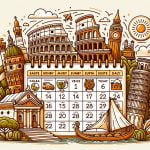Italy, with its rich history, vibrant culture, and stunning landscapes, is a dream destination for many travelers. Imagine immersing yourself in the enchanting beauty of this country for an entire month, exploring ancient ruins, indulging in mouthwatering cuisine, and experiencing the warmth of local traditions. But how much would such a journey cost? In this article, we will delve into the details to help you plan your month-long adventure in Italy within your budget.
Italy is known for its captivating allure that spans centuries. From the iconic landmarks of Rome to the picturesque canals of Venice and the rolling hills of Tuscany, it offers a mosaic of breathtaking landscapes and cultural treasures. However, embarking on such a dream voyage requires careful consideration of expenses. Throughout this article, we will guide you on how to make the most out of your time while managing your budget effectively.
Planning Your Dream Itinerary is crucial to ensure you don’t miss out on any must-visit destinations or experiences during your month-long stay. With its diverse regions and countless cities home to historical sites, art galleries, and stunning natural wonders, Italy has something to offer every traveler. By creating a flexible itinerary that allows for spontaneity while incorporating key destinations into your plans, you can truly maximize your experience in this mesmerizing country.
In the following sections of this article, we will discuss various aspects that will contribute to your unforgettable journey through Italy. We’ll explore different accommodation options suitable for all budgets – from cozy hostels to luxurious villas – ensuring you find the perfect place to call home during your stay.
Additionally, we’ll provide insights on savoring authentic Italian cuisine without breaking the bank, navigating transportation efficiently within Italy’s borders, immersing yourself in local culture through unique experiences and events, budgeting for necessary expenses accurately while including hidden costs you might overlook at first glance.
So whether you’re yearning to wander through ancient ruins or indulge in mouthwatering gelato, let us guide you in creating a budget-friendly itinerary that allows you to explore the magic of Italy for an entire month. Discover the hidden gems, savor the flavors of Italian cuisine, and immerse yourself in the vibrant culture that awaits you in this captivating country. Your dream Italian adventure is about to become a reality – all within your means.
Planning Your Dream Itinerary
When planning your dream trip to Italy for a month, it is essential to map out the perfect itinerary in order to maximize your experience. Italy is a country that boasts diverse regions and must-visit cities, each with its own unique charm and attractions. By creating a flexible itinerary, you can ensure that you don’t miss out on any of the highlights while also allowing room for spontaneous discoveries along the way.
Start by researching the different regions of Italy and their main attractions. From the romantic canals of Venice to the ancient ruins of Rome, the picturesque hills of Tuscany to the stunning Amalfi Coast, there is no shortage of places to explore. Consider what interests you most – whether it’s art and history, natural beauty, culinary delights or all of the above – and prioritize your destinations accordingly.
When mapping out your itinerary, be sure to factor in travel time between destinations. Italy has an efficient public transportation system, including trains and buses, that can get you from one city to another quickly and easily. However, keep in mind that some areas may require more time for exploration than others. For example, cities like Florence and Rome deserve several days each to truly appreciate their cultural offerings, while smaller towns may only require a day or two.
Remember that part of the beauty of traveling is being open to unexpected experiences. While it’s beneficial to have a general plan in place, leave room for spontaneity and flexibility. Allow yourself time to wander through charming streets, stumble upon hidden gems, and engage with locals who can offer insider tips on lesser-known attractions or events happening during your visit.
By mapping out the perfect adventure through a flexible itinerary that combines must-visit destinations with room for spontaneous discoveries, you’ll be able to make the most of your month-long journey in Italy. Embrace all that this enchanting country has to offer and create memories that will last a lifetime.
Determining Your Accommodation
When planning a month-long trip to Italy, one of the most crucial aspects to consider is determining your accommodation. Italy offers a wide range of options, from cozy budget stays to luxurious villas, catering to various preferences and budgets. Here are some options and factors to consider when choosing your accommodation in Italy.
- Budget-friendly hostels: If you’re a solo traveler or on a tight budget, staying at hostels can be a great option. Hostels provide affordable dormitory-style accommodations where you can meet fellow travelers and exchange valuable tips and recommendations. Many hostels in Italy also offer private rooms for those seeking more privacy without breaking the bank.
- Charming bed and breakfasts: For a more intimate experience, consider staying in charming bed and breakfasts (B&Bs). These family-run establishments not only offer comfortable accommodations but also provide an opportunity to interact with locals who can share insider knowledge about the area. B&Bs often serve delicious homemade breakfast, giving you a taste of authentic Italian hospitality.
- Boutique hotels: If you prefer personalized service and unique design, boutique hotels are an excellent choice. Often located in historic buildings or trendy neighborhoods, boutique hotels offer stylish accommodations with attention to detail. While they may be slightly more expensive than other options, boutique hotels provide an unforgettable stay that complements the overall Italian experience.
- Luxurious villas: For those seeking indulgence and exclusivity, renting a luxurious villa can be the perfect option. Italy boasts stunning properties with private pools and breathtaking views of the countryside or coastlines. Villas often come equipped with full kitchens, allowing you to enjoy leisurely home-cooked meals amidst beautiful surroundings.
Consider your budget, preferred location, amenities needed, and desired level of comfort when choosing your accommodation in Italy. Don’t hesitate to explore different booking platforms and consult reviews to ensure a pleasant and memorable stay. Remember, the right accommodation can enhance your Italian adventure, providing a cozy haven to relax after full days of exploring.
Nourishing Your Palate
Italian cuisine is celebrated worldwide for its rich flavors and mouthwatering dishes. When traveling to Italy for a month, indulging in the country’s gastronomic delights is an essential part of the experience. From pasta and pizza to gelato and espresso, Italian cuisine offers a wide variety of delicious options for every palate. In this section, we will explore the significance of Italian gastronomy and provide tips on how to savor authentic Italian food while staying on a budget.
The Significance of Italian Gastronomy
Italian cuisine holds a prominent place in the country’s culture and traditions. Each region in Italy has its own specialties, reflecting the diverse culinary heritage that has been passed down through generations. From the hearty ragù alla bolognese of Emilia-Romagna to the seafood-filled risottos of coastal regions like Liguria and Sicily, Italian cuisine is a reflection of the country’s history, geography, and local produce.
Tips for Savoring Authentic Italian Food on a Budget
While it’s tempting to dine at high-end restaurants during your trip to Italy, there are plenty of ways to enjoy authentic Italian cuisine without breaking the bank. One tip is to seek out local trattorias or osterias where you can find traditional dishes at affordable prices. These family-run establishments often serve homemade pasta, regional specialties, and local wines for a fraction of the cost compared to touristy restaurants.
Another way to save money on meals is by trying street food or visiting local markets. In cities like Rome or Florence, you can find street vendors selling arancini (fried rice balls), pizza al taglio (thin-crust pizza sold by the slice), or panini filled with fresh ingredients.
Exploring local markets can also be an exciting culinary adventure as you browse stalls selling fresh produce, cheese, salumi (Italian cured meats), and other artisanal products. Buying ingredients from the market and preparing your meals can be a cost-effective way to experience Italian cuisine while also engaging with local culture.
Furthermore, it’s worth noting that in Italy, the concept of an ‘aperitivo’ is deeply ingrained in the culture. Many bars offer aperitivo specials where you can enjoy a drink accompanied by unlimited small bites or appetizers. This can be an excellent opportunity to try different flavors and socialize with locals while keeping your food expenses in check.
Getting Around Efficiently
Italy is a country with an efficient and extensive transportation system that makes getting around a breeze. Whether you prefer to travel by train, bus, or rental car, Italy offers various options to suit your needs and preferences.
Trains
One of the most popular ways to travel within Italy is by train. The national railway company, Trenitalia, operates an extensive network of trains that connect major cities and towns across the country. Trains in Italy are known for their punctuality and comfort, making them an ideal choice for long-distance journeys.
- When traveling by train in Italy, it’s recommended to book your tickets in advance to secure the best prices and avoid last-minute hassle. You can easily book tickets online or at any train station.
- Consider purchasing a rail pass if you plan on taking multiple train trips during your month-long stay in Italy. Rail passes offer flexibility and cost savings compared to buying individual tickets.
Buses
Buses are another convenient mode of transportation in Italy, especially for reaching smaller towns and rural areas not well-served by trains. Companies like FlixBus operate routes throughout the country at affordable prices.
- One advantage of traveling by bus is the scenic views you get to enjoy along the way. Sit back, relax, and take in the picturesque countryside as you make your way from one destination to another.
- It’s important to note that buses may be slower than trains due to traffic conditions or longer distances between stops. However, they can be a cost-effective option for budget-conscious travelers.
Rental Cars
For those seeking more independence and flexibility, renting a car can be an excellent choice in Italy. It allows you to explore off-the-beaten-path destinations at your own pace and convenience.
- Before renting a car in Italy, familiarize yourself with the local traffic rules and regulations. Keep in mind that parking can be limited and expensive in major cities, so it’s worth considering public transportation or parking outside city centers.
- Additionally, consider the cost of fuel and toll roads when budgeting for your month-long trip. While rental cars offer freedom, they also come with additional expenses such as gas and highway tolls.
Regardless of which mode of transportation you choose, Italy offers a well-connected network that enables efficient traveling between cities, regions, and even neighboring countries. Take advantage of the various options available to explore all the stunning landscapes and vibrant cities this beautiful country has to offer.
Delving into Italian Culture
Italy is a country rich in culture and history, offering countless opportunities for travelers to immerse themselves in local experiences. To truly discover the essence of Italy, it is important to go beyond the typical tourist attractions and engage with the local culture. In this section, we will explore some ways to delve into Italian culture and make the most of your trip.
One way to experience the authentic Italian way of life is by visiting local markets. These bustling hubs are not only a great place to buy fresh produce and traditional products, but they also offer a glimpse into the daily lives of locals. Sip on an espresso while browsing through colorful stalls filled with fragrant spices, handmade ceramics, and locally sourced cheeses.
Strike up conversations with vendors and sample regional specialties like prosciutto or gelato. By immersing yourself in the vibrant atmosphere of these markets, you can truly get a taste of Italy’s culinary traditions.
Attending festivals and events is another fantastic way to dive into Italian culture. From religious processions to lively music festivals, there is always something happening in Italy. Plan your trip around popular events like Carnevale in Venice or Palio di Siena in Tuscany for an unforgettable experience.
Participate in traditional dances, admire intricate costumes, or cheer on locals as they compete in ancient sports. These events not only showcase Italy’s rich heritage but also provide an opportunity to interact with locals who are proud to share their traditions with visitors.
For those interested in culinary traditions, taking a cooking class can be a memorable cultural experience. Learn how to make handmade pasta from scratch or whip up classic Italian dishes under the guidance of skilled chefs. Cooking classes often include visits to local markets where participants can select fresh ingredients for their creations. Not only will you learn new recipes that you can recreate back home, but you will also gain insights into Italian culinary techniques and traditions.
By immersing yourself in local experiences such as visiting markets, attending festivals, and participating in cooking classes, you can gain a deeper understanding of Italian culture and create lifelong memories. Interacting with locals and embracing their traditions will enrich your travel experience and provide a unique perspective on this magical country. So go ahead, venture beyond the tourist sites and discover the true heart of Italy.
| Experience | Description |
|---|---|
| Visiting Local Markets | Immerse yourself in the vibrant atmosphere of colorful stalls offering traditional products and sample regional specialties. |
| Attending Festivals and Events | Experience Italy’s rich heritage by participating in religious processions or cheering on locals at lively music festivals. |
| Taking Cooking Classes | Learn how to make handmade pasta or classic Italian dishes while gaining insights into culinary techniques and traditions. |
Budgeting Your Expenses
Italy is a dream destination for many travelers, and a month-long trip to this beautiful country can be a truly magical experience. However, to make your dreams come true, it is important to budget and plan accordingly. In this section, we will break down the cost of a month in Italy, helping you understand the expenses involved and enabling you to plan your budget more effectively.
When it comes to budgeting for a month in Italy, it’s important to consider several key expenses. Accommodation will likely be one of your biggest costs. The average daily cost of accommodation in Italy can range from $40 for a budget-friendly hostel to $250 or more for a luxurious villa. By staying in budget-friendly accommodations and opting for shorter stays in more expensive options, you can strike a balance between affordability and comfort.
Another significant expense is food. Italian cuisine is renowned worldwide for its delicious flavors and fresh ingredients. While dining out at fancy restaurants every day can quickly add up, there are ways to savor authentic Italian food without breaking the bank. Eating at local trattorias and pizzerias instead of touristy restaurants can save you money while still providing an authentic culinary experience. Additionally, shopping at local markets and cooking some meals yourself can help reduce costs.
Transportation is another aspect that should be factored into your budget. Italy has an extensive public transportation system that includes trains, buses, and ferries. These options are not only affordable but also convenient for getting around the country. Purchasing rail passes or regional transport cards can further help reduce transportation costs.
| Expense | Approximate Cost |
|---|---|
| Accommodation (budget-friendly hostel) | $40 per night |
| Accommodation (luxurious villa) | $250 per night |
| Meals (average daily cost) | $15 – $30 |
| Transportation (public transportation) | $1.50 – $5 per ticket |
It’s important to keep in mind that these figures are rough estimates and can vary depending on factors like the season, location, and personal preferences. By planning and budgeting ahead, you can have a clearer understanding of the costs involved in your Italian adventure and make the most of your time in this incredible country.
Tips for Saving Money
Dining on a Budget
One of the best ways to save money while experiencing Italian cuisine is by dining at local trattorias. These family-run establishments offer authentic Italian dishes at affordable prices. By venturing away from tourist areas and seeking out local recommendations, you can enjoy delicious meals that won’t break the bank.
Another tip is to take advantage of lunch specials, as many restaurants offer discounted menus during this time. Additionally, consider opting for aperitivo, a popular Italian tradition where bars serve small plates of food with your drink order. This can be a cost-effective way to sample different types of Italian appetizers and snacks.
Advance Booking and Travel Hacks
To stretch your budget when it comes to accommodation and transportation, it’s important to plan ahead and book in advance. This allows you to take advantage of early bird discounts and secure the best rates. When it comes to flights, consider using flight comparison websites or signing up for fare alerts to snag the best deals.
Another travel hack is to book your accommodations slightly outside of major cities or tourist hotspots, as prices tend to be lower in these areas. It’s also helpful to be flexible with your travel dates, as flying during off-peak seasons or weekdays often results in lower fares.
Affordable Shopping and Souvenir Hunting
While exploring Italy’s charming streets and lively markets, keep an eye out for affordable shopping opportunities that go beyond traditional souvenir shops. Look for local artisans selling handmade crafts or jewelry, which make unique and meaningful souvenirs at reasonable prices. Additionally, visit neighborhood flea markets where you can find vintage clothing, antiques, books, and other treasures without breaking the bank.
If you’re a fan of fashion or designer labels, consider visiting outlet malls located in various regions throughout Italy. These offer discounted prices on popular brands for those looking for some retail therapy.
By following these smart strategies and incorporating them into your travel plans, you can save money while still enjoying all that Italy has to offer. With careful budgeting and a bit of creativity, you’ll be able to stretch your budget and have the Italian adventure of a lifetime. So start planning today, and get ready to immerse yourself in the magic and wonder of this captivating country.
Conclusion
As you reach the end of this article, it is clear that a dream Italian adventure awaits you. Italy offers a magical experience that combines cultural richness, exquisite cuisine, stunning scenery, and warm hospitality. By following the tips and suggestions outlined in this article, you can embark on a month-long journey that will create memories to last a lifetime.
Planning your dream itinerary is essential to make the most of your time in Italy. The country is filled with diverse regions and must-visit cities, each offering unique experiences and attractions. By creating a flexible itinerary, you can ensure that you have the freedom to explore hidden gems and adapt your plans according to your interests and preferences.
Diving into Italian culture is another crucial aspect of your journey. From visiting local markets to participating in cooking classes or attending festivals, immersing yourself in local experiences will provide a deeper understanding of the country’s traditions and way of life. Engaging with locals will not only enrich your trip but also create meaningful connections and lasting memories.
Budgeting for your month-long adventure may seem daunting at first, but with careful planning and smart strategies, it is feasible to experience Italy without breaking the bank. By considering accommodation options, sampling mouthwatering Italian cuisine while staying on a budget, utilizing efficient transportation methods, and taking advantage of money-saving tips, you can stretch your budget while still enjoying all that Italy has to offer.
So why wait any longer? Start planning and budgeting for your unforgettable Italian journey today. Whether you choose the art-filled cities of Florence and Rome, the stunning landscapes of Tuscany or Cinque Terre, or the romantic charm of Venice – there is something for everyone in Italy. Embrace the allure of this captivating country and get ready for an adventure filled with history, beauty, gastronomy, and endless possibilities. Your dream Italian adventure truly awaits.
Frequently Asked Questions
How much money do you need to stay in Italy for a month?
The amount of money needed to stay in Italy for a month can vary greatly depending on various factors such as the chosen accommodations, dining preferences, transportation choices, and desired activities. On average, a comfortable budget for a month-long stay in Italy could range from $2,000 to $4,000 per person.
This should cover expenses like lodging in mid-range hotels or vacation rentals, meals at local restaurants or self-catering options, transportation within cities and between regions via public transport, occasional museum visits or guided tours, and some leisure activities.
What is the average cost of a month in Italy?
The average cost of spending a month in Italy can depend on several factors including personal preferences and travel style. Generally speaking, if you opt for mid-range hotels or vacation rentals and enjoy local cuisine at moderate-priced restaurants while occasionally treating yourself to more upscale experiences, you can expect an average monthly cost ranging from $3,500 to $6,000 per person.
This estimation includes accommodation costs, meals, transportation within the country (both local and regional), entrance fees to landmarks or attractions, as well as additional expenses like purchasing souvenirs or participating in unique local activities.
How much does a decent trip to Italy cost?
The cost of a decent trip to Italy greatly depends on your individual expectations and travel choices. For those seeking comfort without extravagance during their visit to this beautiful country, a decent trip can be planned with a budget of around $2,500 to $4,500 per person for two weeks.
This budget should cover reasonably comfortable accommodations (potentially mid-range hotels or vacation rentals), enjoying delicious Italian cuisine at local eateries but also savoring some upscale dining experiences intermittently. Additionally, it will encompass transportation costs within cities and between regions using public transport options like trains or buses along with some cultural excursions like visiting famous landmarks or taking guided tours to immerse yourself in the Italian heritage.

I’m a passionate traveler, writer, and Italophile. My fascination with Italy’s history, art, and culture has led me on countless adventures across the Italian landscape. Through “I Live Italy,” I share my love for this extraordinary country and aims to inspire others to explore its boundless beauty.





